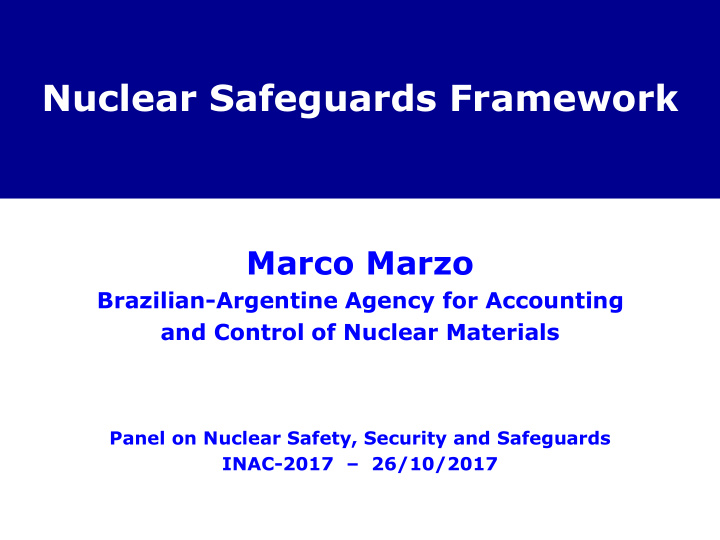



Nuclear Safeguards Framework Marco Marzo Brazilian-Argentine Agency for Accounting and Control of Nuclear Materials Panel on Nuclear Safety, Security and Safeguards INAC-2017 – 26/10/2017
Outlines • The Nuclear Non-Proliferation Regime • Objectives of Nuclear Safeguards • Safeguards Legal Framework • Awareness of Safeguards • Differences to Security Culture
The Non-Proliferation Regime Allowing benefits of the nuclear energy applications Build trust to Essential part of strengthen the the international cooperation among security the countries 3
Non-Proliferation Regime 4
Non-Proliferation Regime Successful? • In the 60s: experts expected ~30 countries with nuclear weapons in 20 - 30 years Non-proliferation commitments are mandatory and verifiable 5
NPT Framework Great Adherence: 191 countries as of Jan 2017 193 Members 168 Members 194 Members 211 Members
Safeguards Objectives Nuclear Safeguards aim to avoid the proliferation of nuclear weapons by : • timely detecting diversion of significant quantities of declared nuclear materials; • confirming the operational status of nuclear facilities, and • assuring the absence of undeclared nuclear materials and facilities. The adversary is a State 7
Objective of Nuclear Security “The prevention, detection of, and response to, theft, sabotage, unauthorized access, illegal transfer or other malicious acts involving nuclear material, other radioactive substances or their associates facilities” Physical protection regime has been an essential element of the State’s nuclear security regime The focus is a non-state actor Prevention Detection Response
The Safeguards System Nuclear Safeguards Nuclear National Safeguards Facility Authority Organization
Awareness of Safeguards • Poor awareness of safeguards • No tangible perception of risks • General perception that safeguards is a government business • Lack of education and training • Safeguards training provided by the IAEA is still limited
Awareness of Safeguards • Unlike Safety and Security, no associations or network of stakeholders in safeguards • Currently the only Safeguards Network is the Asia Pacific Safeguards Network (2009) • ESARDA, INMM, NGOs, Institutes – Not dedicated exclusively to safeguards – Not involving all stakeholders, in particular facility personal – More conceptual than operational
Safeguards: Differences to Security Culture (1) • Mandatory regime: Agreements & Verification • State oriented: No non-state actors • Provision of information, including sensitive one: commercial, technological, R&D • Perception of importance: – State x Public Perception
Safeguards: Differences to Security Culture (2) • International guidance quite limited, in particular at facility level • Interest in sharing information among stakeholders? • Less influenced by human factor than security and safety – However poor human performance can degrade the effectiveness of safeguards systems
How (lack of) Culture affects the Quality of Safeguards Implementation • Ignorance: – No awareness of the importance of safeguards – Lack of commitment – Weak safeguards hierarchy in the state system • Lack of Continuity of Knowledge – Frequent change of players – No knowledge of agreements, arrangements, procedures
Thank you! Marco Marzo Secretary marzo@abacc.org.br ABACC Brazilian-Argentine Agency for Accounting and Control of Nuclear Materials www.abacc.org.br
Recommend
More recommend